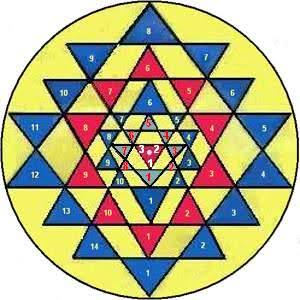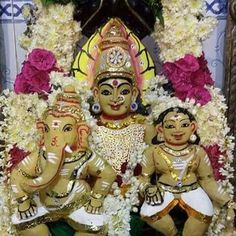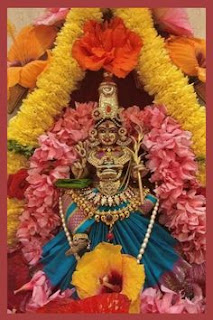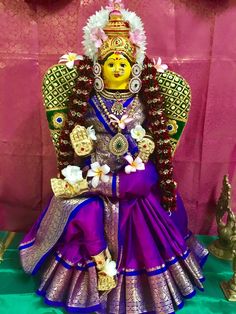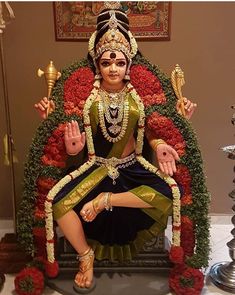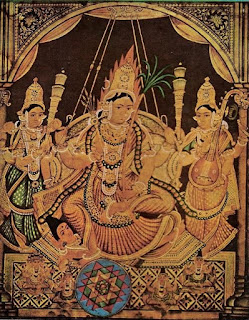अपर्णा (754)
Aparṇā
She is without debts. When apa (negation) is prefixed to rṇā (debts) it means She is without debts. She repays the devotion of Her devotees by granting boons to them, thereby not indebted to Her devotees. She is not even indebted to Śiva because She takes care of His acts of creation, sustenance and dissolution.
Aparṇa also means without leaves. It is said that She did penance for attaining Śiva without even taking leaves. Aparṇa as such means Durga or Pārvatī.
चण्डिका (755)
Caṇḍikā
She is Durga. She is said to be inaccessible because of Her anger. She is the combined form of Durga, Lakṣmī and Sarasvatī.
चण्ड-मुण्डासुर-निषूदिनी (756)
Caṇḍa-muṇḍāsura-niṣūdinī
Caṇḍa and Muṇḍa are the two demons who were killed by Her and hence She is known as Cāmuṇḍa. Cāmuṇḍā is the form of Kālī. All these forms are only manifestations of Lalitāmbikā.
क्षराक्षरात्मिका (757)
Kṣarākṣarātmikā
Kṣara means syllables and akṣara means alphabets. Syllable is formed by the combination of alphabets. This nāma means She is mono-syllable and multi-syllable. In other words, She is one as well as many.
सर्व-लोकेशी (758)
Sarva-lokeśī
She is Īśvarī for all the worlds. She rules all the worlds.
विश्व-धारिणी (759)
Viśva-dhāriṇī
She holds the universe. Viśva means the universe and dhāriṇī means holding.
त्रि-वर्ग-दात्री (760)
Tri-varga-dhātrī
Tri-varga means puruṣārtha-s. She is the giver of puruṣārtha-s. Puruṣārtha-s are dharma (righteousness), artha (wealth or purpose), kāma (desire) and mokṣa (liberation).
सुभगा (761)
Subhagā
Five year old girl is known subhaga. Among others, bhaga also means sun, Goddess Sāvitrī, good fortune, welfare, prosperity, dignity etc. Su is used an adjective to the word bhaga. It means She is the incarnation of good fortunes of the highest order.
त्र्यम्बका (762)
Tryambakā
She has three eyes. Sun, moon and fire are Her three eyes .
त्रिगुणात्मिका (763)
Triguṇātmikā
Guṇa or qualities are of three types, sattvic, rajas and tamas. She's the essence of of all the guna-s.
स्वर्गापवर्गदा (764)
Svargāpavargadā
She gives svarga or heaven and liberation.
शुद्धा (765)
Śuddhā
She is pure. She is the embodiment of purity.
जपा-पुष्प-निभाकृतिः (766)
Japā-puṣpa-nibhākṛtiḥ
Japā-puṣpa means hibiscus flower. She has the complexion of hibiscus flower (deep red or crimson) is mentioned in dhyāna verse.
ओजोवती (767)
Ojovatī
Ojas means body vitality, the principle of vital warmth and action throughout the body. Ojas is said to be the eighth substance of a body. This is a sentient life energy prevailing in the spinal cord. This is the combination of five cognitive senses known as jñānendriya. Whatever is consumed, food or perceptions first get transformed into ojas in the spinal cord. She is in the form of ojas.
द्युति-धरा (768)
Dyuti-dharā
She radiates brilliantly. This illumination is due to initial and final stages of “I” consciousness. This I consciousness is known as aham in Sanskrit. Aham is the comprehension of the entire cosmos, which is the expression of the creative brilliance of Śaktī.
यज्ञ-रूपा (769)
Yajña-rūpā
Viṣṇu is the Supreme authority for yajña-s. Yajña means fire ritual where oblations are offered with mantra recitations. She is in the form of Viṣṇu.
प्रिय-व्रता (770)
Priya-vratā
She is fond of vows.
दुराराध्या (771)
Durārādhyā
She is difficult to attain. The process of attaining Her is difficult, as mind control is paramount in Her worship.
दुराधर्षा (772)
Durādharṣā
She cannot be controlled. She can be controlled only by unstained devotion. Pretentious worship is not liked by Her.
पाटली-कुसुम-प्रिया (773)
Pāṭalī-kusuma-priyā
Pāṭalī (Bignonia Suaveolens) is red and white flower. Red represents Śaktī and white represents Śiva and hence this flower is said to represent both Śiva and Śaktī.
Śiva is fond of bilva tree and Śaktī is fond of pāṭalī tree.
महती (774)
Mahatī
She's an embodiment of intellect, knowledge and supremacy. Mahat means buddhi or intellect.
मेरु-निलया (775)
Meru-nilayā
She lives atop Meru. Meru is a fabulous mountain regarded as the Olympus of Hindu mythology and said to form the central point of Jambu-dvīpa.
मन्दार-कुसुम-प्रिया (776)
Mandāra-kusuma-priyā
She is fond of mandāra flowers . Mandāra tree is one of the five trees in Svarga (heaven).
वीराराध्या (777)
Vīrārādhyā
Vīrā-s mean warriors.
She is worshipped by courageous warriors.
विराड्-रूपा (778)
Virāḍ-rūpā
Virāḍ is the consciousness which identifies itself with the individual gross body in the waking state. Consciousness can be broadly classified into microcosm and macrocosm. Microcosm is the individual consciousness and macrocosm is the universal consciousness. She's in the form of all consciousness.
विरजा (779)
Virajā
Vi means without and rajas means impurity. She is without impurity.
विश्वतो-मुखी (780)
Viśvato-mukhī
She has faces in all directions.
प्रत्यग्-रूपा (781)
Pratyag-rūpā
She is visible to those who see inwardly. She can be realized only within and this is known as Self-realization. By disconnecting mind from sensory afflictions and looking within, She is realized.
पराकाशा (782)
Parākāśā
She is the supreme ākaś or ether or space. Parākāśa is often used to mean the Brahman. Since She is the Brahman, She is compared to ākaś.
प्राणदा (783)
Prāṇadā
She is the giver of vital breath or prāṇa.
प्राण-रूपिणी (784)
Prāṇa-rūpiṇī
She is the embodiment of prāṇa.
मार्ताण्ड-भैरवाराध्या (785)
Mārtāṇḍa-bhairavārādhyā
She is worshipped by Mārtāṇḍa-bhairava who is posited in the twenty fourth prahāra (wall) of Śrī puraṁ. Śrī Cakra is in the centre of this Śrī puraṁ. Some are of the opinion that Mārthaṇda-bhairava is the sun, who also worships Her.
मन्त्रिणी-न्यस्त-राज्यधूः (786)
Mantriṇī-nyasta-rājyadhūḥ
She has entrusted the ministerial responsibilities of the universe to Mantriṇī. Mantriṇī is feminine gender for minister. Her minister is Śyāmalā.
त्रिपुरेशी (787)
Tripureśī
Śiva had burnt Tripura, a place of asura-s (demons) fortified with gold, silver and iron forts. These are nothing but stages of ignorance. Śiva who burnt this place is known as Tripura and His wife is Tripureśī.
जयत्सेना (788)
Jayatsenā
She has a victorious army.
निस्त्रैगुण्या (789)
Nistraiguṇyā
She is devoid of three guṇa-s, Rajas, Tamas and Sattvic.
परापरा (790)
Parāparā
There are three forms of the Brahman, para, apara and parā-para.
Muṇḍaka Upaniṣad (II.i.4) says “there are two kinds of knowledge, Para, the Superior cosmic knowledge, that by which one knows the Brahman, which always remains the same and never decays.”
Apara , the inferior knowledge, relates to the phenomenal world and comprises of the four Vedas, rituals, grammar, phonetics, etymology, etc. Parāpara is the intermediate stage between the highest and lowest, a sort of mediocre stage. Śaktī is known as Parā-Śaktī based upon these factors.
सत्यज्ञानानन्द रूपा (791)
Satyajñānānanda rūpā
Satya is truth, jñāna is knowledge and ānanda is bliss. She is the combination of truth, knowledge and bliss.
सामरस्य-परायणा (792)
Sāmarasya- parāyaṇā
Parāyaṇa means devoted to or engaged with chief authority. She is devoted to the principle of equality. With whom She is equal? Of course, with Śiva. Without each other, they cannot function. They have attained each other after performing rigorous penance.
कपर्दिनी (793)
Kapardinī
Hair of Śiva is known as Kaparda. Kaparda means braided and knotted hair (Śrī Rudraṁ V.4). His wife is Kapardinī.
कलामाला (794)
Kalāmālā
She wears a garland made out of sixty four Kalā-s.
कामधुक् (795)
Kāmadhuk
She gives whatever is desired by Her devotees.
कामरूपिणी (796)
Kāmarūpiṇī
She is capable of assuming various forms at Her will. Kāma means desire and rūpiṇī means form.
कलानिधिः (797)
Kalānidhiḥ
She is the source of kalā-s . Kalā means arts. There are sixty four types of arts or Kalā-s. Kalā also means beauty.
काव्यकला (798)
Kāvyakalā
Kāvya is one of the arts. Kāvya means endowed with the qualities of a sage or poet, descended or coming from a sage, prophetic, inspired, or poetical. This nāma means She is the inspiration or the source for kāvya-s.
रसज्ञा (799)
Rasajñā
Rasa means essence or flavour. Saundarya Laharī (verse 51) refers to eight types of rasa-s. They are love, resentment, anger, wonder, fear, grace, smile and kindness. In addition to the above eight two more rasa-s contentment and fondness are also referred.
This nāma means She is the finest of these rasa-s.
रस-शेवधिः (800)
Rasa-śevadhiḥ
She is the treasure receptacle of rasa.









